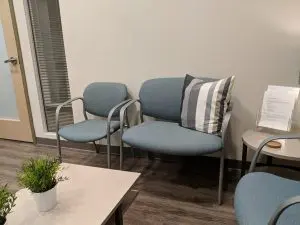by J George | Intern Architect / Access Planner
The first time I came across an oversized chair was during my bariatric consultation appointment in 2013. At the time I weighed 300 lbs and was an expert at knocking things over thanks to what my grandfather would have referred to as “womanly hips.” For the first time in my life, a piece of furniture could hold my weight and was designed to do so. At restaurants, I used to strategize my seating arrangement based on proximity to adjacent tables to not disrupt others when I stood up. There were plenty of times where I got stuck in armed chairs, theatre seating, and even rollercoaster seats due to my large frame. To those who think forcing people with eating disorders to use smaller chairs would encourage them to lose weight, guess what? It doesn’t. If anything, it makes us eat more out of stress. My lifestyle was in no way healthy, but it was comforting to know that the world could accommodate me as I was and not constantly berate me with strictly Lilliputian objects.

These chairs (referred to as bariatric, oversized, or extra wide) have seen a boon in the healthcare industry since[1] and seem to pop up wherever I go. My most recent encounter was during a routine doctor’s appointment last week. This time I weighed 195 lbs – I discovered my ability to knock things over was due in part to genetic clumsiness. Though I lost all that weight, I still feel as though I need to maneuver carefully around people and things. After 15+ years of being overweight/obese, it became muscle memory. I found myself sitting in the oversized chair the minute after I checked in. This time I was delighted to be able to see the fabric beneath me rather than being completely eclipsed by my thighs. These chairs should not be pigeonholed in the medical field. It unintentionally creates an identity as being a “sick person’s chair” or a “fat chair.” By providing these seats in more social/cultural environments (i.e., restaurants, cafés, museums, libraries, etc.), it facilitates more interaction between “the obese” and “the skinny.” It becomes more than a chair; it becomes a welcoming invitation to exist within the space.
[1] Allen, C. (2014, June 11). Bariatric Chair – Welcome Everyone to Your Medical Office [Blog Post] Retrieved March 26, 2018, from http://blog.worthingtondirect.com/healthcare-furniture/bariatric-chairs-welcome-everyone-to-your-medical-office/


